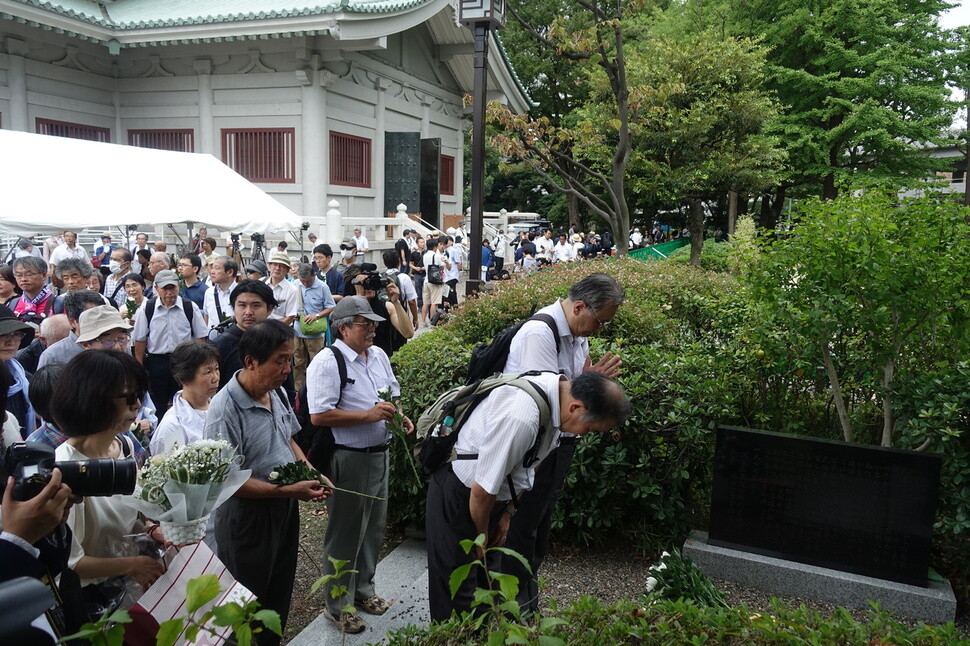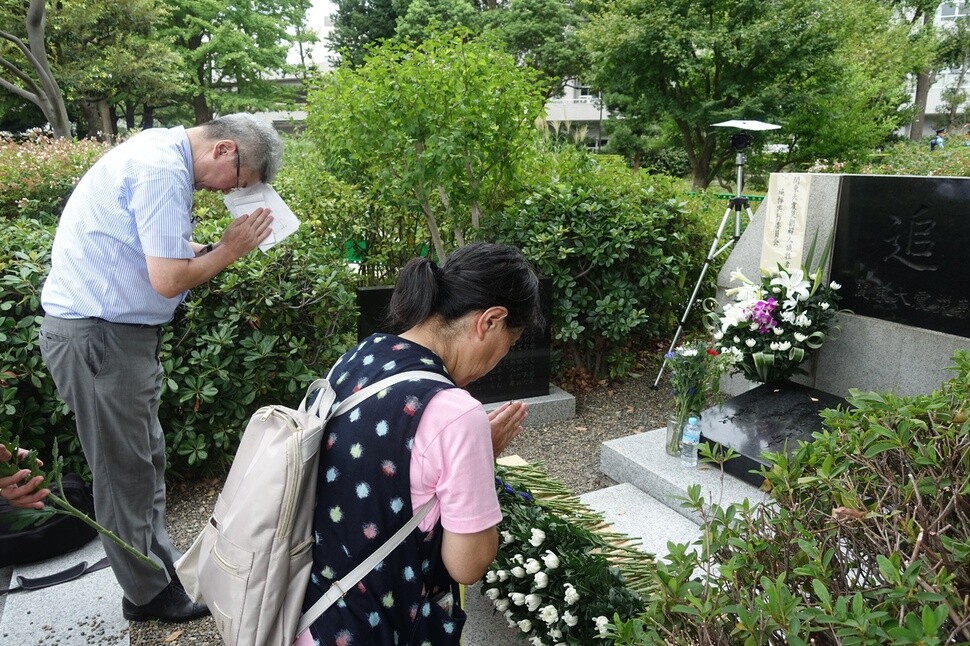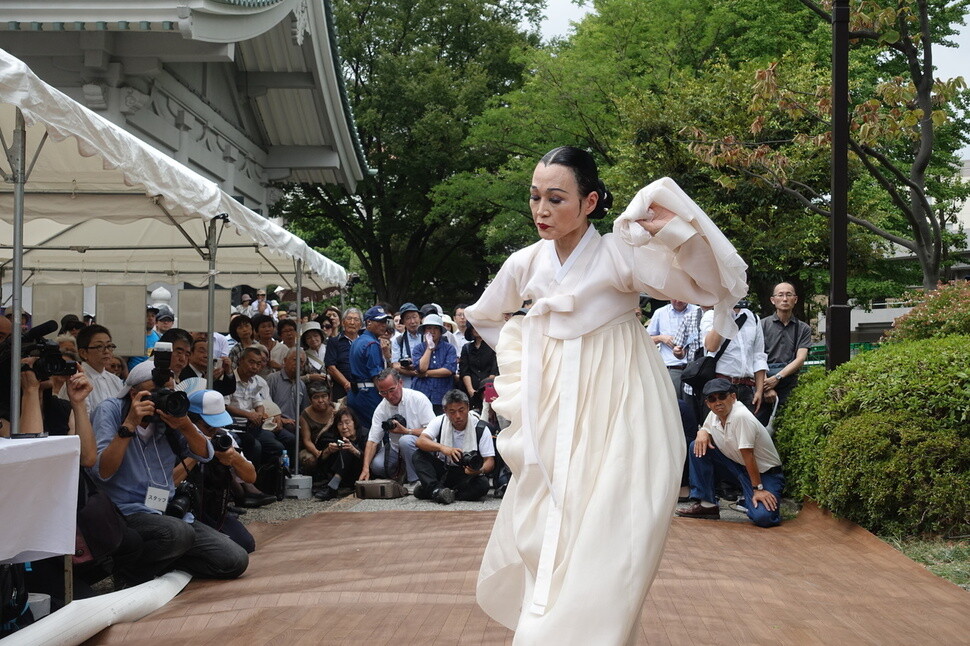hankyoreh
Links to other country sites 다른 나라 사이트 링크
[Reportage] 700 people gather in Tokyo for memorial of Koreans massacred during Great Kanto Earthquake

“I express my deepest condolences to the many victims of the Great Kanto Earthquake, starting with the Koreans whose precious lives were taken as a result of violence by the military and vigilantes. I believe that discriminatory attitudes toward Koreans and the arrogance of Japanese colonial rule over Korea were factors behind the massacre.”
The summer heat had yet to subside at Yokoamicho Park in Tokyo’s Sumida ward on the morning of Sept. 1. Seven hundred people – more than double the number the year before – had come to attend a 95th anniversary commemorative ceremony for the Koreans massacred in the wake of the 1923 Great Kanto Earthquake.
Just before the event was to conclude with the ceremonial laying of flowers on the memorial stone, the host of the event read a message from Tomiichi Murayama, the former Prime Minister who proclaimed the eponymous “Murayama statement” in 1995 apologizing for Japan’s past colonial rule.

“Reflection on this shameful history as Japanese people and showing a sense of duty in achieving a society of symbiosis with our Asian neighbors was the starting point for postwar Japan,” Murayama declared in his message. During the ceremony, messages were also read on behalf of former Prime Minister Yukio Hatoyama, Democratic Party of Japan (Japan’s top opposition party) leader Yukio Edano, Seoul Mayor Park Won-soon, and Japanese Communist Party secretary general Akira Koike.
Hatoyama declared that “Japan’s future and peace in Asia cannot be built without breaking the chains of discrimination and creating a society of brotherly love.” Park noted that “both the Japanese government and the South Korean government have ignored this incident for nearly a century.”
There was a sad reason for the outpouring of sympathies from major figures in different fields this year which had not been expressed in years before. It was a form of protest after Tokyo Governor Yuriko Koike moved last year to stop sending condolence messages as her predecessors had done in the past.
“We collected signatures from 9,000 individuals and over 140 groups to send to the city of Tokyo asking them to submit a commemorative statement, but the city refused in a phone call later,” said chairman Yasuhiko Miyakiwa of the Japan-Korea Association’s Tokyo federation, one of the civic groups organizing the event.
“After that, one of the members suggested that we gather messages from other people to take the place of the Tokyo governor’s commemorative statement,” he explained.
The massacre following the Great Kanto Earthquake
In 1973, a memorial stone was placed in Yokoamicho Park to honor the Korean victims of massacres at the time of the earthquake. After the Great Kanto Earthquake occurred in 1923, false rumors were spread in Japan that Koreans had poisoned wells; military police and vigilante groups are estimated to have slain over 6,000 Koreans. A half-century later, a movement to raise a memorial stone in Tokyo began; then-Tokyo Governor Ryokichi Minobe, famous for his innovative policies, supported the effort.
In a 1974 commemorative statement the year after the stone’s raising, Minobe wrote, “The horrific actions [after the earthquake] continue to pierce our conscience.” Statements were also sent by most subsequent governors, including famously conservative Shintaro Ishihara. But Koike declared last year that she would not be submitting commemorative remarks for Korean victims alone, insisting that she would instead express condolences for all Kanto earthquake victims together.
Tokyo government refuses to submit commemorating remarks starting last year
This year, the Tokyo Metropolitan Government appears to be moving to make its refusal to submit remarks commemorating Korean massacre victims into a regular practice rather than a onetime decision.
“We will not be submitting any more in the future either,” the government has declared.

The Sumida ward chief also declined to submit commemorative remarks for a second straight year. After citing similar grounds as Koike’s for declining to submit remarks last year, the chief did not even provide a reason this year.
“I think the idea is to ignore the history of Koreans being massacred and make it as though it never happened,” Miyakawa said of Koike’s refusal to share a memorial message.
“The evasion of historical facts is an even greater disgrace,” he said.
The Tokyo deputy governor attended a commemorative Buddhist service in Yokoamicho Park the same day for victims of the Great Kanto Earthquake. The deputy governor read a statement on Koike’s behalf expressing “heartfelt condolences to the surviving family members,” but made no specific mention of Korean massacre victims.
Nearby the ceremony for the Korean victims, members of conservative groups hung banners reading “Claims of ‘thousands of massacre victims’ are a fabrication” and “Preserve the honor of the Japanese.”
Many Japanese civic groups are deeply concerned about what they see as the move to purge the massacre of Koreans after the Great Kanto Earthquake from history. Since July, the Korea Museum in Tokyo’s Shin-Okubo neighborhood has been holding an exhibition titled “Depictions of the Korean Massacre and Vulnerable Members of Society.”
Included in it are rarely exhibited images from the collection of Japan’s National Museum of Japanese History. Paintings showing children playing “games” of hunting Koreans or hearing impaired people being mistaken for Koreans and slaughtered testify to the tragic events at the time.
By Cho Ki-weon, Tokyo correspondent
Please direct comments or questions to [english@hani.co.kr]

Editorial・opinion
![[Column] Season 2 of special prosecutor probe may be coming to Korea soon [Column] Season 2 of special prosecutor probe may be coming to Korea soon](https://flexible.img.hani.co.kr/flexible/normal/500/300/imgdb/original/2024/0426/3317141030699447.jpg) [Column] Season 2 of special prosecutor probe may be coming to Korea soon
[Column] Season 2 of special prosecutor probe may be coming to Korea soon![[Column] Park Geun-hye déjà vu in Yoon Suk-yeol [Column] Park Geun-hye déjà vu in Yoon Suk-yeol](https://flexible.img.hani.co.kr/flexible/normal/500/300/imgdb/original/2024/0424/651713945113788.jpg) [Column] Park Geun-hye déjà vu in Yoon Suk-yeol
[Column] Park Geun-hye déjà vu in Yoon Suk-yeol- [Editorial] New weight of N. Korea’s nuclear threats makes dialogue all the more urgent
- [Guest essay] The real reason Korea’s new right wants to dub Rhee a founding father
- [Column] ‘Choson’: Is it time we start referring to N. Korea in its own terms?
- [Editorial] Japan’s rewriting of history with Korea has gone too far
- [Column] The president’s questionable capacity for dialogue
- [Column] Are chaebol firms just pizza pies for families to divvy up as they please?
- [Column] Has Korea, too, crossed the Rubicon on China?
- [Correspondent’s column] In Japan’s alliance with US, echoes of its past alliances with UK
Most viewed articles
- 1Samsung subcontractor worker commits suicide from work stress
- 2‘We must say no’: Seoul defense chief on Korean, USFK involvement in hypothetical Taiwan crisis
- 3Is Japan about to snatch control of Line messenger from Korea’s Naver?
- 4Division commander ordered troops to enter raging flood waters before Marine died, survivor says
- 5[Editorial] Korea’s surprise Q1 growth requires objective assessment, not blind fanfare
- 6No good, very bad game for Korea puts it out of Olympics for first time since 1988
- 7US overtakes China as Korea’s top export market, prompting trade sanction jitters
- 8Korea’s 1.3% growth in Q1 signals ‘textbook’ return to growth, says government
- 9N. Korean delegation’s trip to Iran shows how Pyongyang is leveraging ties with Moscow
- 10[Column] Season 2 of special prosecutor probe may be coming to Korea soon